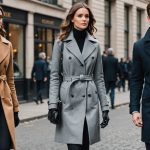Upgrade Your Winter Style: The Definitive Guide to Picking the Ideal Professional Coat
As the temperatures drop and the snow starts to fall, it’s time to upgrade your winter wardrobe with the perfect professional coat. A good coat is more than just a piece of clothing; it’s a statement of style, a symbol of professionalism, and a guardian against the cold. Here’s a comprehensive guide to help you choose the ideal coat that fits your needs, enhances your style, and keeps you warm.
Understanding Your Needs: Activity and Climate
Before diving into the world of winter coats, it’s crucial to understand your specific needs. Are you looking for a coat to brave the extreme cold of the Antarctic or something more suited for the milder winters of urban life?
Also read : The perfect trench coat: a comprehensive guide for cozy rainy uk commutes
For Extreme Cold
If you’re facing temperatures that can drop to -30°C or lower, you need a coat that is designed for extreme conditions. The Canada Goose Expedition Parka is a prime example of such a coat. Originally designed for scientists in Antarctica, this parka is filled with goose down, is windproof, water-resistant, and features a adjustable hood filled with down, a storm flap, and internal backpack straps for hands-free transport[1].
For Urban Professionals
For those who need a coat that is both stylish and functional in urban settings, the Quartz Co. Down Parka is an excellent choice. Made in Canada, this coat combines ethical 650-fill down with a water and wind-resistant fabric, making it both functional and elegant. It features a removable hood, storm cuffs, and a YKK VISLON zipper, perfect for braving polar vortex conditions in the city[1].
Additional reading : Transform Your Modern Office: Creative Strategies for Adding Vintage Flair
Choosing the Right Material
The material of your coat is pivotal in determining its warmth, durability, and style.
Natural Materials
Natural materials like wool, cashmere, and leather are excellent for retaining body heat. Wool, for instance, is a natural insulator and can be found in various types of coats, from the classic pea coat to the more formal trench coat. Here’s why wool is a great choice:
- Breathability: Wool allows moisture to escape, preventing you from feeling too hot or sweaty.
- Warmth: It provides excellent insulation even when wet.
- Durability: Wool coats can last for many years with proper care.
Synthetic Materials
Synthetic materials, on the other hand, offer a more affordable and often lighter alternative. The Kanuk Blizzard Coat uses synthetic Thermo+ insulation, which provides superior lofting power, thermal efficiency, and performance in humid conditions[1].
Key Features to Consider
When choosing a winter coat, there are several key features you should consider to ensure you get the best fit for your needs.
Water Resistance
A water-resistant coat is essential for keeping you dry and warm. Look for coats with a waterproof and breathable membrane like Gore-Tex or similar technology. The The North Face New Thermoball™ Eco jacket, for example, uses a 100% recycled polyester fabric that is both water-resistant and environmentally friendly[4].
Insulation
The type of insulation can significantly impact the warmth of your coat. Here are some common types:
- Down Insulation: Provides excellent warmth but can lose its insulating properties when wet.
- Example: Canada Goose Expedition Parka
- Synthetic Insulation: Retains warmth even when wet and is often more affordable.
- Example: Kanuk Blizzard Coat
- Hybrid Insulation: Combines down and synthetic insulation for balanced performance.
- Example: The North Face New Thermoball™ Eco
Layering System
A good winter coat should be part of a layering system to ensure you stay warm and comfortable. Here’s how to layer effectively:
- Base Layer: Moisture-wicking fabrics to keep you dry.
- Mid Layer: Insulating layers like fleece or wool.
- Outer Layer: Your coat, which should be windproof and water-resistant[4].
Stylish and Professional Options
Your winter coat doesn’t have to sacrifice style for warmth. Here are some stylish and professional options:
Trench Coats
Trench coats are a classic choice that can add a touch of sophistication to any outfit. They are typically made of wool or a wool-blend fabric and feature a belted waist and epaulets.
- Example: A double-breasted trench coat in black or navy is versatile and professional.
Pea Coats
Pea coats are shorter and more fitted, making them perfect for a more modern look.
- Example: A navy pea coat with a fitted silhouette and double-breasted front is both stylish and warm.
Parkas
Parkas can be both functional and stylish, especially when chosen in neutral colors.
- Example: The Quartz Co. Down Parka in black or navy is both elegant and functional[1].
Practical Tips for Choosing Your Coat
Here are some practical tips to help you make the right choice:
Fit
- Make sure the coat fits well without being too tight or too loose. You should be able to wear layers underneath comfortably.
- Consider the length of the coat. Longer coats provide more coverage but may not be as stylish as shorter ones.
Color
- Choose neutral colors like black, navy, or gray that can be easily paired with other items in your wardrobe.
- Avoid bright colors unless you’re looking to make a bold fashion statement.
Accessories
- Add accessories like scarves, hats, and gloves to enhance your look and add extra warmth.
- Example: An earflap hat and insulated gloves can make a big difference in cold weather[2].
Budget and Value
Coats can range from affordable to very expensive, so it’s important to consider your budget and the value you’re getting.
Affordable Options
- Look for sales during events like Black Friday to get discounts on high-quality coats.
- Consider faux fur or synthetic insulation for a more affordable option.
Investment Pieces
- Invest in a high-quality coat that will last for many years.
- Example: A wool coat from a reputable brand can be a worthwhile investment.
Table: Comparing Key Features of Winter Coats
| Coat Type | Material | Insulation | Water Resistance | Style | Price Range |
|---|---|---|---|---|---|
| Trench Coat | Wool or Wool-Blend | None | Water-Resistant | Classic, Sophisticated | $200-$1000 |
| Pea Coat | Wool | None | Water-Resistant | Modern, Fitted | $150-$800 |
| Parka | Synthetic or Down | Down or Synthetic | Water-Resistant | Functional, Stylish | $200-$1500 |
| Expedition Parka | Down | Down | Water-Resistant | Extreme Weather | $1000-$2000 |
| Synthetic Parka | Synthetic | Synthetic | Water-Resistant | Practical, Affordable | $100-$500 |
Quotes and Insights from Experts
- “The key to choosing the right winter coat is to consider your lifestyle and the activities you’ll be doing. If you’re going to be in extreme cold, you need a coat that can handle it,” says a fashion expert from Altitude Sports[1].
- “Layering is essential for staying warm. Make sure your coat is part of a system that includes a base layer, mid layer, and outer layer,” advises a guide from The North Face[4].
Building a Capsule Wardrobe
A capsule wardrobe is about having a few high-quality, versatile pieces that can be mixed and matched to create multiple outfits.
Essential Coats for a Capsule Wardrobe
- One Trench Coat: A classic choice that can be dressed up or down.
- One Pea Coat: A shorter, more modern option for everyday wear.
- One Parka: For colder days or outdoor activities.
Choosing the right winter coat is not just about staying warm; it’s about making a statement with your fashion. Whether you’re looking for something stylish and professional or practical and functional, there’s a coat out there for you. Remember to consider your needs, choose the right material, and don’t forget to layer. With these tips and insights, you’ll be well on your way to upgrading your winter style and staying warm in style.
Final Tips
- Read reviews and check the ratings of the coat you’re interested in to ensure it meets your expectations.
- Make sure to check the return and exchange policies in case the coat doesn’t fit as expected.
- Consider the standard delivery options and any additional costs for expedited shipping.
By following this guide, you’ll be able to find the perfect coat that enhances your style, keeps you warm, and fits seamlessly into your wardrobe. Happy shopping











